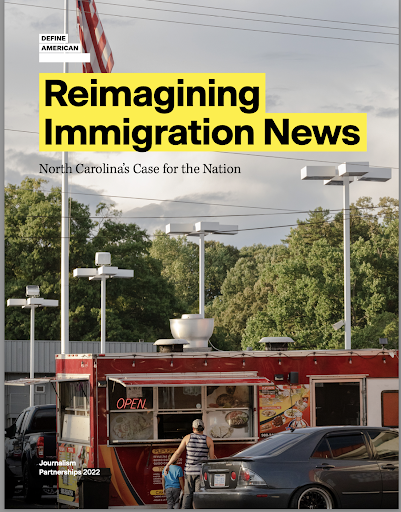Check out the full NC Local newsletter from November 9 for more from the Workshop, including industry news, job postings and shout-outs to journalists statewide. Sign up to get NC Local in your inbox every Wednesday.
By Eric Frederick, NC Local Newsletter Editor
We in North Carolina’s news and information community are getting our closeup with Define American’s new journalism research report, “Reimagining Immigration News: North Carolina’s Case for the Nation.” We also have a gauntlet at our feet.
Liz Robbins, Define American’s director of journalism partnerships and the report’s lead author, wrote for Poynter on October 27 about why North Carolina was the focus of this research and analysis of how we cover immigration news. She cited our state’s fast-growing, diverse and vibrant immigrant communities; its deficiencies in reporting on them but with some notable exceptions, particularly in bilingual collaborations; and its varied application of immigration law. (“It’s a complex place.”)
Two days later she moderated a panel at the Society of Professional Journalists in Washington with three North Carolina journalists who are answering the challenge: Victoria Bouloubasis, award-winning freelance journalist and co-author of the report; Paola Jaramillo, executive editor and co-founder of Enlace Latino NC; and Daniel Viotto, lead anchor and managing editor of Telemundo Charlotte.
You should download and read the report in detail, but some of the key takeaways were these:
- Immigration is usually considered an expendable beat.
- Coverage focuses on Latinx communities and largely ignores AAPI residents.
- The reporting often reinforces stereotypes.
- Skimping on coverage of immigrant communities is not good business.
The report offers seven recommendations at the end (and most of them don’t require money — just smart changes in priority and approaches).
In an email exchange, Liz talked a little more with me about what’s working, what’s not, and what’s next:
EF: Are you still glad you chose North Carolina as your model?
LR: Absolutely! What a vibrant news ecosystem. Even though we found deficiencies in immigration coverage, we also wanted to uplift what some legacy and nonprofit outlets are doing well to center immigrant communities. We conclude with seven recommendations for newsroom leaders in every state.
EF: What surprised you the most?
LR: There are two stats that blew me away.
- Of the approximately 300 media outlets in the state, there are only three reporters dedicated to covering immigrant communities as a beat. Three. That’s down from six in 2021. All three are funded by Report for America. When McClatchy terminated its relationship with RFA, that led to the demise of two of those positions. We had to subtract one more in the middle of writing this! La Voz, a grant-funded Spanish-language edition of the Chatham News + Record, put its operation on hold in July after its ace reporter Victoria Johnson left to work in a law office. That sent the editor, Bill Horner III, searching for more funding. An epitaph for how precarious the climate is for local news.
(EF: Got an update here, and some good news. Horner confirmed to me Tuesday that a $30,000 grant awarded two weeks ago by the NC Local News Lab Fund would go toward resurrecting La Voz. “We’ve got to find a fluent Spanish and English reporter who wants to be in the market,” he told me, “but we definitely want to get it back going.”)
- Asian American and Pacific Islanders are North Carolina’s fastest-growing ethnic and racial group. Their immigrant population increased by 65,000 from 2006 to 2019. And yet, less than 4 percent of North Carolina immigration news stories were about AAPI communities. Sayaka Matsuoka, an editor and reporter at Triad City Beat, told us that most news outlets (including her own) don’t have the reporters, money, or time to cover the diversity of the rapidly growing AAPI population. Unless it’s breaking news.
EF: That’s depressing. What’s the good news?
LR: Collaborations!
North Carolina’s on the vanguard of collaborative journalism. Three collaborations between Spanish language and English language outlets are showing us how it’s done. As you’ve covered here, Ju-Don Marshall, the chief content officer at WFAE public radio in Charlotte, created a position that would share a reporter with La Noticia, the oldest Spanish-language newspaper in the state. Funding from RFA supported this. We showed how Telemundo Charlotte works with newsroom partners WSOC-TV in Charlotte (both are owned by Cox Media Group), to share sources (who are bilingual) and resources (a news helicopter) to cover breaking stories. Finally, we highlighted Enlace Latino NC’s partnership with Southerly magazine (with a Solutions Journalism grant) because it covers the intersection of economic mobility and environmental issues in Latinx and immigrant communities. Victoria Bouloubasis authored this series, which won a prestigious LION award for Collaboration of the Year last month, in addition to two others. Enlace Latino is becoming a national leader in local immigrant news.
EF: Glad to see these weren’t proverbial puff pieces. You pointed out missteps that complicated the narrative.
LR: At WFAE, the RFA reporters needed to educate their editors about using language that wouldn’t offend their Spanish-speaking sources (“undocumented” instead of “illegal”) or being able to use native Spanish pronunciation in English audio. La Noticia wanted quick-hit stories to feed their digital audience, but the reporters also needed time to establish sources. Marshall, understanding the need for cultural competency, shuffled coordinating editors. At WSOC, the news director, Mike Oliveira, thought that Telemundo news crew would just draft off them for stories, but quickly corrected his thinking when he saw the experienced journalists in Viotto, and Eloy Tupayachi, the lead producer. WSOC colleagues were skeptical that Telemundo’s reporting on ICE raids was veering towards advocacy, so Viotto and Tupayachi met with them, explaining how they cover the government fairly while providing service journalism. The pandemic brought them together. And then, this past year, Oliveira hired Linda Nester to coordinate coverage between the two news stations. Collaborations take time and work.
EF: You mentioned that McClatchy would not allow you to speak to its editors or reporters. How were you able to work around this?
LR: I am still baffled by McClatchy’s fierce unwillingness to participate. Their input could have benefited them, especially had I been able to understand more about how Aaron Sánchez-Guerra covered crimes involving immigrants for The News & Observer, and how Laura Brache covered “diverse communities” there. Her 2021 piece on a team of Indian immigrant cricket players that got the town of Morrisville to revamp the cricket stadium was a revelatory feature of our audience survey.
EF: That was quite a metric of impact in that survey.
LR: I know! We found that 46 percent of North Carolina news consumers expressed false, stereotypical views of immigrants. And yet, after reading this cricket story, 94 percent of the survey participants agreed the immigrants in the story, at least, were “good citizens.” Integrating sports and business makes people relate to their neighbors. Wouldn’t it have been nice to know how subscriptions rose after this story was published to further prove this impact? The bottom line: legacy news organizations need to understand that not only is this responsible journalism to cover all communities, it’s also good business.
EF: What makes this report so distinctive?
LR: The methodology. Define American is a nonprofit, nonpartisan organization rooted in research. My colleague, our director of research and evaluation, Sarah E. Lowe, collaborated with the Media Ecosystems Analysis Group, which conducted a content analysis of 22 representative media outlets in North Carolina. Sarah worked with the University of Florida’s Center for Public Interest Communications to do an audience survey to gauge their attitudes and beliefs on immigrants, and how news coverage impacted them. Carolina Demography at UNC-Chapel Hill analyzed the Census trends. I reported in the state with award-winning freelance journalist Victoria Bouloubasis, who’s based in Durham. We hired Asheville photographer Juan Diego Reyes to feature journalists and community members. And, for the big finish? We offer solutions for news leaders to make their coverage more inclusive. Plus, the design is super sharp!
EF: So, what now?
LR: I have a tagline that all news leaders can follow: Integrate. Collaborate. Educate. The next step is going to newsrooms around the country. I have one-hour workshops ready so that all staff can understand best practices for immigration reporting. That way, if they can’t afford to hire an immigrant communities reporter, they can better integrate their coverage and understand the context for nuanced reporting.
EF: What was the best part of your reporting trips?
LR: The food, of course! El Toro Bruto taqueria in Charlotte, where we got to hang out with the chef, Hector González-Mora. Pho at Lang Van in Charlotte. And amazing pan dulce from a small shopping center bakery in Greenville. I’ll be back.




